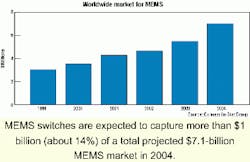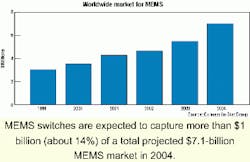MEMS switching...and beyond
Many companies have embraced MEMS-based photonic switching, but the technology behind these devices can vary widely.
MARLENE BOURNE, Cahners In-Stat Group
The march toward an all-optical network continues as the communications industry tries to keep pace with the demand to seamlessly move larger and larger amounts of data, voice, and video at increasingly higher speeds. One way to do that is to replace current optical-electrical-optical switches, which must convert optical signals into electrical signals and then back into optical form for further transmission.
Thus, the race is on to develop a new class of switches that can avoid such signal conversion. A technology generating considerable buzz is micro-electromechanical systems, or MEMS. Cahners In-Stat Group defines MEMS as micron-sized devices that can sense the physical environment and/or manipulate gases, light, or liquids. Fabricated via various micromachining processes, the end result is typically a structure that is made from silicon and has moving parts-although not always.
First commercialized in the early 1990s, MEMS can be found in medicine, transportation, industrial, and consumer applications of all kinds. That is primarily due to their extremely small size, which allows MEMS in many instances to be capable of faster, more precise operation than their macroscopic counterparts.
To date, there have only been a few high-volume, high-visibility end uses. Many believe the next such application for MEMS is optical switching.
There are two types of MEMS switches being developed: mechanical and microfluidic. Mechanical switches utilize an array of micromachined mirrors that can range into the hundreds of thousands-all on a single chip. Microfluidic-based switches, on the other hand, rely on the movement of liquid in small channels that have been etched into a chip. In a mirror-based switch, an array of micromachined mirrors is typically fabricated in silicon. Control signals applied to the MEMS chip fix the position of each individual mirror to direct each incoming light signal to the desired output port.Mirror-based switches can be classified according to mirror movement. In two-dimensional devices, the mirrors are only able to execute a two-position operation; that is, the mirrors can move either up and down or side to side. In 3D switches, the mirrors can assume a wide variety of positions by swiveling in multiple angles and directions (see Photo).
While most major players are going the micromirror-based route, Agilent Technologies is taking advantage of the company's knowledge of microfluidics and has developed a switch based on Hewlett-Packard's inkjet printing technology. The switch consists of intersecting silica waveguides, with a trench etched diagonally at each point of intersection. The trenches contain a fluid that in default mode allows the light to travel through the switch. To switch the light, bubbles are formed and removed hundreds of times per second in the fluid, which then reflect the light to the appropriate output port.
So how exactly are the mirrors (and bubbles) controlled? There are three kinds of actuation mechanisms being used in MEMS switching: electromagnetic, electrostatic, and thermal:
- Electrostatic is the most common and well-developed method of MEMS actuation, since IC processes provide a wide selection of conductive and insulating materials. By using the conductors as electrodes and the insulators for electrical isolation of the electrodes, electrostatic forces can be generated by applying a voltage across a pair of electrodes. This type of actuation tends to require lower power levels than other methods and is the fastest.
- Magnetic actuators usually require relatively high currents (and high power), which can limit their use. In addition, these mechanisms use magnetic materials that are not common in IC technology and often require some type of manual assembly. The choice of magnetic materials is limited to those that can be easily micromachined. However, electromagnetic microactuators can be much faster and consume far less power than thermal actuators.
- With thermal actuators, heating is accomplished by passing a current through the device. Unfortunately, the heating elements can require high power consumption. Plus, the heated material has to cool down to return the actuator to its original position, so the heat has to be dissipated into the surrounding structure. That can take time, possibly affecting speed.
There are three basic means of fabricating MEMS devices: surface micromachining, bulk micromachining, and LIGA (lithography, plating, and molding):
- Surface micromachining involves the building up of various layers of materials selectively left behind or removed by subsequent processing. As such, the bulk of the substrate remains essentially untouched.
- With bulk micromachining, a large portion of the substrate is removed to form whatever structure is desired. Therefore, structures with greater heights are easier to fabricate, because thicker substrates can be used.
- LIGA combines the basic process of IC lithography with electroplating and molding to obtain depth. In LIGA, patterns are created in a substrate, which are then electroplated to create 3D molds. While these molds can be used as a final product, a variety of materials can also be injected into them to produce a product. This technique has two distinct advantages: materials other than silicon can be used (in particular, metal and plastic) and devices with very high aspect ratios can be built.
Most MEMS switch manufacturers are relying on bulk micromachining methods. Agilent Technologies is using a hybrid process called CMOS MEMS, which combines conventional CMOS (complimentary metal-oxide semiconductor) processing with several micromachining steps. To date, AXSUN Technologies is the only company that has developed a switch fabricated using the LIGA method.
The majority of MEMS switches currently support 32 bidirectional ports or fewer, although companies are working hard to develop devices that can support more than 1,000 ports. The big question is whether a large matrix array is better than scaling smaller switches together.Some manufacturers are using small switch modules as building blocks to create a large switch fabric. It's believed that the scaling of smaller switch modules provides flexibility, allowing customers to add to a device, as they need it. Others don't consider this solution efficient and are working on developing large matrix arrays greater than 1,000x1,000, an approach thought to be more preferable because scaling results in power loss.
Regardless of size, speed is an important consideration. A number of switches based on competitive technologies such as liquid crystal and thermo-optics are faster than many current MEMS switches. However, those developing MEMS switches are working hard to improve this issue in next-generation devices.
Demonstrated to switch any type of data, at any protocol (SONET/SDH, ATM, Internet Protocol, Ethernet), at any wavelength, there's no doubt MEMS switches will find a lucrative niche in optical networks. MEMS switches are expected to capture more than $1 billion of a $7.1-billion total MEMS market in 2004 (see Figure). In-Stat is basing its forecast only on the cost of the packaged MEMS chip itself (i.e., the micromirror array); not the cost of the system in which the chip is contained nor the end cost of the switch itself.
But what we've seen so far is just the first wave. It's very likely that MEMS will have an even greater impact in the future beyond switching. A number of companies are already hard at work developing other MEMS-based components for use in optical networks, including attenuators, tunable filters, and tunable lasers. (Attenuators are used in DWDM units to equalize the power of each wavelength, while the role of tunable filters is to monitor channel wavelengths, power levels, and signal/noise ratios to ensure signal integrity.) Certainly these devices are still in various stages of development, but they bear close watching.
So will MEMS be the optical switch of the future? It's still too soon to tell, but it appears that MEMS is the right technology, in the right place, at the right time.
Marlene Bourne is a senior analyst with Cahners In-Stat Group (Scottsdale, AZ). She can be reached at 480-609-4541; e-mail, [email protected]; www.instat.com.


